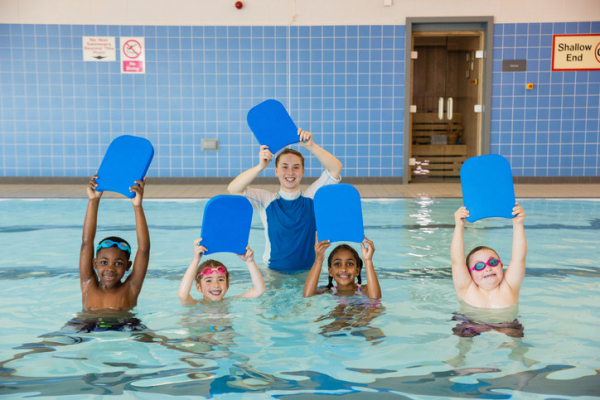
Before going any further, here’s the main thing parents should know about swimming lessons: all children should have them.
Every day, about 11 people die from drowning in the United States. Swimming lessons can’t prevent all of those deaths, but they can prevent a lot of them. A child doesn’t need to be able to swim butterfly or do flip turns, but the ability to get back to the surface, float, tread water, and swim to where they can stand or grab onto something can save a life.
10 things parents should know about swimming lessons
As you think about swimming lessons, it’s important to know:
1. Children don’t really have the cognitive skills to learn to swim until they are around 4 years old. They need to be able to listen, follow directions, and retain what they’ve learned, and that’s usually around 4 years old, with some kids being ready a little earlier.
2. That said, swim lessons between 1 and 4 years old can be useful. Not only are some kids simply ready earlier, younger children can learn some skills that can be useful if they fall into the water, like getting back to the side of a pool.
3. The pool or beach where children learn must be safe. This sounds obvious, but safety isn’t something you can assume; you need to check it out for yourself. The area should be clean and well maintained. There should be lifeguards that aren’t involved in teaching (since teachers can’t be looking at everyone at all times). There should be something that marks off areas of deeper water, and something to prevent children from getting into those deeper areas. There should be lifesaving and first aid equipment handy, and posted safety rules.
4. The teachers should be trained. Again, this sounds obvious — but it’s not always the case. Parents should ask about how teachers are trained and evaluated, and whether it’s under the guidelines of an agency such as the Red Cross or the YMCA.
5. The ratio of kids to teachers should be appropriate. Preferably, it should be as low as possible, especially for young children and new swimmers. In those cases, the teacher should be able to have all children within arm’s reach and be able to watch the whole group. As children gain skills the group can get a bit bigger, but there should never be more than the teacher can safely supervise.
6. There should be a curriculum and a progression — and children should be placed based on their ability. In general, swim lessons progress from getting used to the water all the way to becoming proficient at different strokes. There should be a clear way that children are assessed, and a clear plan for moving them ahead in their skills.
7. Parents should be able to watch for at least some portion. You should be able to see for yourself what is going on in the class. It’s not always useful or helpful for parents to be right there the whole time, as it can be distracting for children, but you should be able to watch at least the beginning and end of a lesson. Many pools have an observation window or deck.
8. Flotation devices should be used thoughtfully. There is a lot of debate about the use of “bubbles” or other flotation devices to help children learn to swim. They can be very helpful with keeping children safe at the beginning, and helping them learn proper positioning and stroke mechanics instead of swimming frantically to stay afloat, but if they are used, the lessons should be designed to gradually decrease any reliance on them.
9. Being scared of the water isn’t a reason not to take, or to quit, swimming lessons. It’s common and normal to be afraid of the water, and some children are more afraid than others. While you don’t want to force a child to do something they are terrified of doing, giving up isn’t a good idea either. Start more gradually, with lots of positive reinforcement. The swim teacher should be willing to help.
10. Just because a child can swim doesn’t mean he can’t drown. Children can get tired, hurt, trapped, snagged, or disoriented. Even strong swimmers can get into trouble. While swimming lessons help save lives, children should always, always be supervised around water, and should wear lifejackets for boating and other water sports.
The Centers for Disease Control and Prevention website has helpful information on preventing drowning.
Follow me on Twitter @drClaire



